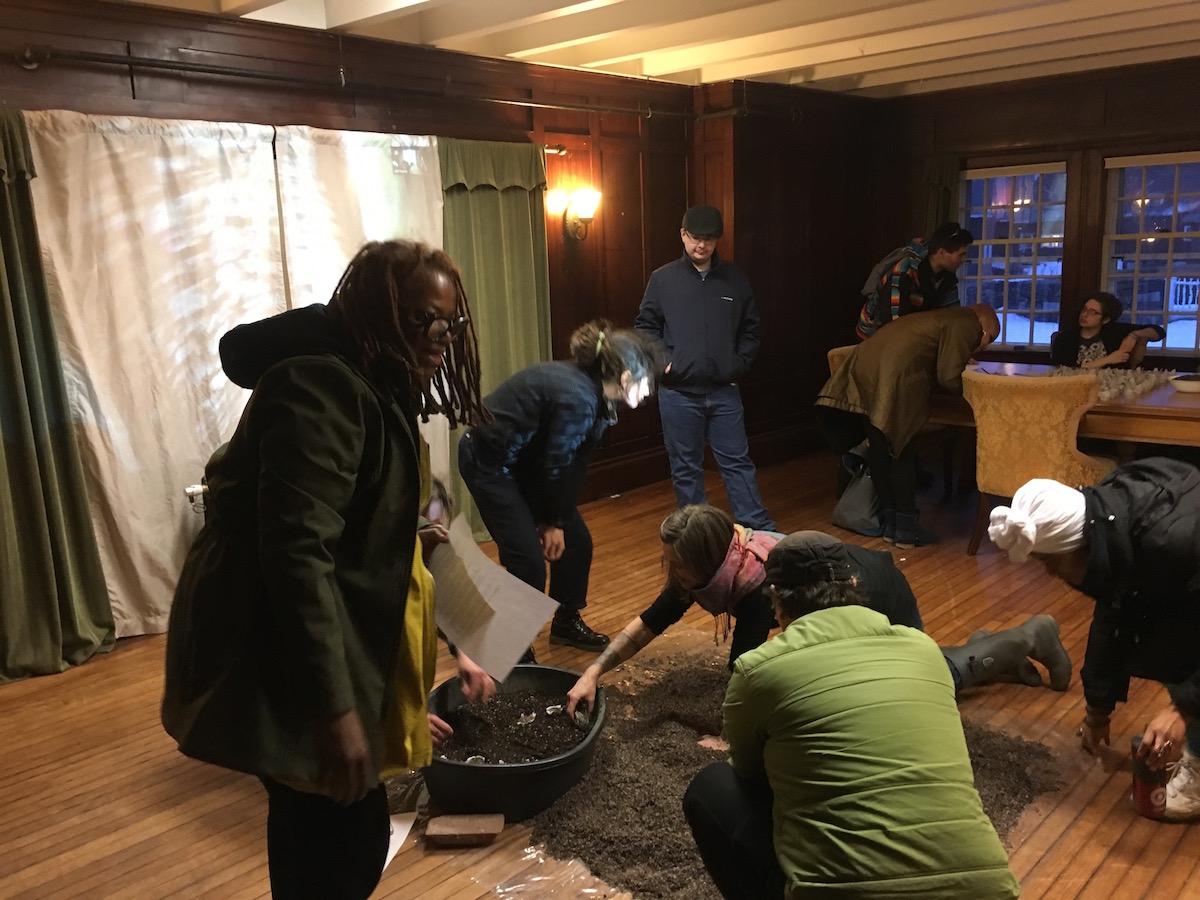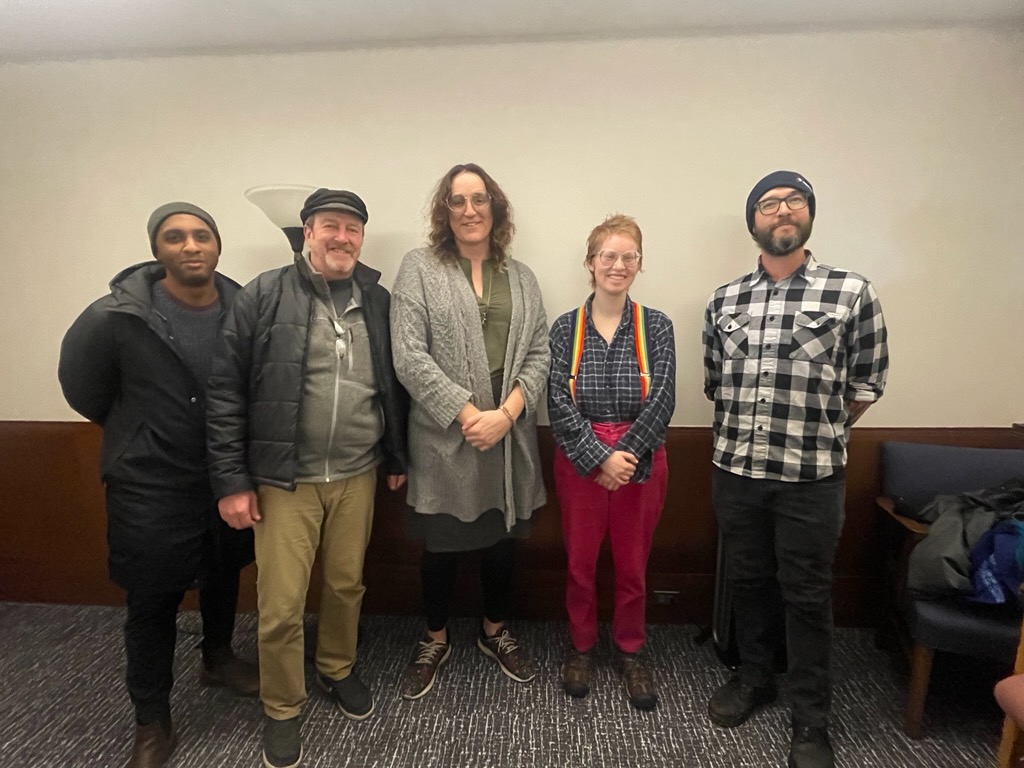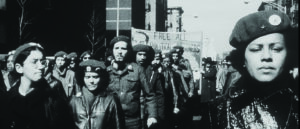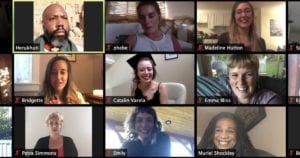
August 9, 2019
The last time I sat at this table, it was a place where things got stuck: an expanse of oak in a stuffy room where we sat across from a president that sheepishly told us no action was possible, the recommendations of the diversity workgroup were unrealistic, of course he agreed in principle, but…
(Silence.)
Tonight that silence is exorcised by pulsing electronic music. The heavy table is covered in seedling cups, shoved aside to make room for the tarp of potting soil. The air is pungent.
The inaugural class of Goddard College’s new BFA in Socially Engaged Art, has taken over the former president’s office for a participatory installation, inviting members of the college community to imagine inclusive futurities together. On one side of the room, students sit in oversized chairs navigating virtual representations of the campus. In the center of the room, we pot sunflower seeds beneath the projected live-stream choreography of a student who is unable to attend the residency for health reasons. At the table, student-artists sustain a dialogue with participants about the history and future of the institution.

As it wraps up its first year, the BFA in Socially Engaged Art is home to an intriguing mix of artists, spanning the disciplines of media art, printmaking, theater, video, painting, textile, music, performance, comics, circus, dance, and design. Like all programs at the college it is low-residency; students spend the first eight days of the semester together in a residency in Vermont, and then return home to Philly, Seattle, Maine, Texas, Mexico City, etc. videoconferencing into their group studies and virtual studio visits with faculty advisers. Each student designs their own project-based curriculum, and together and as a community we grapple with the question of what Socially Engaged Art is—figuring out what it means to design creative and material practices around the thorny questions of instrumentality, identity, engagement and an ethics of care.
It is not coincidental that the first project the BFA students produced deals explicitly with the past and future of the institution itself. Founded in 1938, in the conviction that democratic education could counter the global rise of fascism, Goddard has been a pirate utopia of experimental learning for 80 years. This meshes nicely with the persistent interest that “social practice” and “participatory art” have had in pedagogical practice. As Claire Bishop writes
Pedagogic art projects therefore foreground and crystallise one of the most central problems of all artistic practice in the social field: they require us to examine our assumptions about both fields of operation, and to ponder the productive overlaps and incompatibilities that might arise from their experimental conjunction, with the consequence of perpetually reinventing both.[1]
To teach or learn socially engaged art is to occupy contested spaces, to push in multiple directions simultaneously. On the one hand, it is about enlisting the principles of critical pedagogy and liberatory social theory against the marble citadel of the “fine arts” and its complicity in cultural imperialism and luxury economies. On the other hand, it is a matter engaging art’s ability to disrupt the “knowledge economy” by centering the contingent, the embodied, the felt, enacting what Pablo Helguera describes as:
A powerful and positive reenvisioning of education that can only happen in art, as it depends on art’s unique pattern of performativity, experience, and exploration of ambiguity.[2]
This can be difficult terrain to navigate, especially in the context of academic capitalism, where “education is increasingly a financial investment rather than a creative space of freedom and discovery; a career move, rather than a place of epistemological inquiry for its own sake.”[3] How does one market a BFA program that is grounded in critiques of both academia and the art world? What job training does it provide?
This program presumes that reinvention is the necessary work—the job—of the artist in this moment, not out of some avant-garde valorization of “the new,” but as a counter to the structural violence associated with setter-colonialism, imperialism, white supremacy, capitalism, and cisheteropatriarchy. In her scathing “Open Letter” to the curators and staff of the Whitney Biennial, Hannah Black wrote:
Although derided by many white and white-affiliated critics as trivial and naïve, discussions of appropriation and representation go to the heart of the question of how we might seek to live in a reparative mode, with humility, clarity, humour and hope, given the barbaric realities of racial and gendered violence on which our lives are founded. I see no more important foundational consideration for art than this question.[4]
Adopting this “foundational consideration” doesn’t just change an artists relationship to institutions, but reframes all aspects of artistic practice from aesthetics and form to craft and material practice to audience and distribution. It changes the way a body inhabits a stage, the way a painter chooses color and brush. Technique, therefore, cannot simply be received from master to pupil. Instead we must invent, adapt, and be in dialogue with each other, each of us (re)discovering what it means to make art that is “socially engaged.” It requires a relational and dynamic model of learning: the experiment that Goddard College has always aspired to be.
The “job training” for an artistic practice that reinvents art in a reparative mode requires criticality, cultural competencies, and a fair amount of scrappiness. Words such as revolution, “infiltration,” and subversion are not unwarranted, since systems are not inclined to dismantle themselves. Therefore, we need to have honest conversations about how art can engage existing structures of power strategically while remaining accountable to the communities that have been marginalized by them. To engage in art-making as change-making—as trouble-making—artists might need to take up Fred Moten and Stefano Harney’s invitation to “sneak into the university and steal what one can… to join its refugee colony.”[5]
Yes, let’s learn to draw the body, to orchestrate, to program, and to produce something beautiful. Let’s learn to do it well—but let’s never do only that.
At some point, as we planted these seeds, the new president wanders in. He joined the students sitting at his predecessor’s table. Looking out over the soil he responded to the prompts and asked what it would look like for Goddard to enact practices of “radical hospitality.”
We’re going to find out. You’re invited.
[1] Bishop, Claire. Artificial hells: Participatory art and the politics of spectatorship. Verso Books, 2012. 247.
[2] Helguera, Pablo. Education for Socially engaged art. New York, NY: Jorge Pinto Books, 2011. 81.
[3] Bishop, Claire. Artificial hells. 269.
[4] D’Souza, Aruna. Whitewalling: Art, Race & Protest in 3 Acts. Badlands Unlimited, 2018.
[5] Harney, Stefano, and Fred Moten. The undercommons: Fugitive planning and black study. Minor Compositions, 2013. 26.







